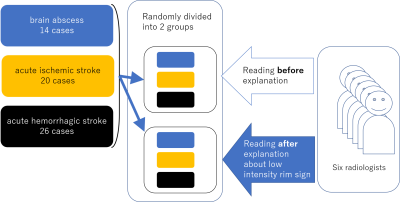Takashi Abe1,2, Maki Otomo2, Rintaro Ito1, Rei Nakamichi1, Yumi Abe1, Toshiki Nakane1, Hisashi Kawai1, Toshiaki Taoka1, Shinji Naganawa1, and Masafumi Harada2
1Nagoya University, Nagoya, Japan, 2Tokushima University, Tokushima, Japan
1Nagoya University, Nagoya, Japan, 2Tokushima University, Tokushima, Japan
In this retrospective image interpretation study
showed an accuracy of 70% for differentiating brain abscess, acute ischemic,
and hemorrhagic stroke, but by focusing on the low intensity rim, the accuracy increased
to 86% (p = 0.025), confirming the importance of low intensity finding on DWI.

This retrospective study included
14 cases of untreated brain abscess, 20 cases of acute ischemic stroke and 26
cases of acute hemorrhagic stroke. One representative DWI was selected and
randomly divided into two groups. Six radiologists (7 to 20 years of
experience) reviewed one group consists of 30 DW image before any guidance. The
interpretation of another group was carried out after the explanation about the
characteristics of low intensity on DWI.

